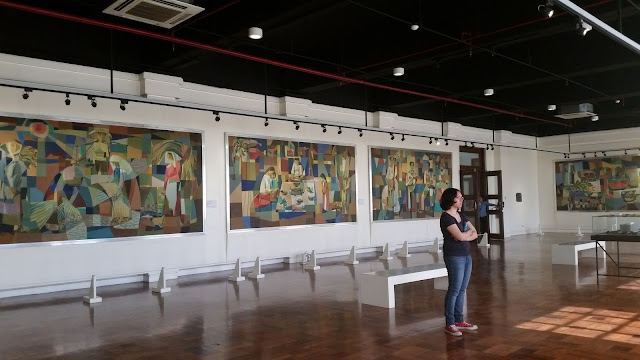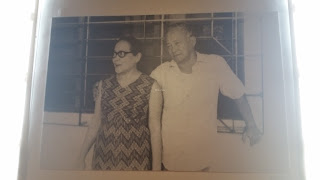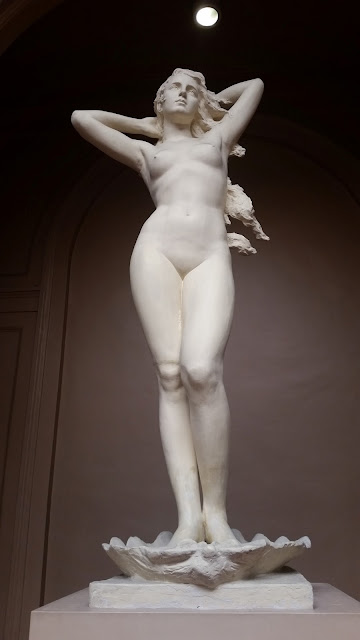Afternoon fun at the National Museum
 |
| Spoliarium by Juan Luna - oil on canvas, 1884 |
Last May 2015, National Museum declared that the admission was going to be free because it was the museum month. Despite my fever, I persuaded my family that a trip to the National Museum and see Vicente Manansala's paintings was a good reason to get out of my sick bed. That, and because my parents haven't been inside the National Museum yet! (Photos are unedited. Please do not grab my photos without permission or credit.)
 |
| Mother's Revenge by Jose Rizal - terra cotta, 1894 |
It was fun going to National Museum with my family. My parents were clearly delighted, and looked like a young couple, with my dad frequently had his arm around mama. #relationshipgoals
I also remembered some tidbits from history in high school, like the fact that Jose Rizal also made some sculptures. Then I discovered some new-to-me artists and work I haven't seen before. I love art, and being in the National Museum filled with incredible paintings and info just made the geek in me thrilled to the bones.
Some of the artworks that stood out for me are:
National Artist Guillermo Tolentino's Diwata. This was the first time I've seen it, and I cannot help but take a picture. Look at the draping of the dress, at the fluidity of the folds at the bottom, contrasting the seeming rigidity of the wingspan. It speaks to me of both femininity and power, even as exhibits a slight vulnerability with her arms up.
 |
| Diwata by Guillermo Tolentino - reinforced concrete, ca. 1950s |
Vista de un Barrio, Guagua by Francisco de Paula Rodoreda. It was done in watercolor, and the details were so precise, and the painting so soothing that I just had to take a picture.
 |
| Vista de un Barrio, Guagua by Rodoreda, watercolor, ca. 1890 |
 |
| Portrait of a Lady by Antonio Luna, 1891 |
 |
| Carabaos in Pink by Romeo V. Tabuena - oil on board, 1957 |
Aside from the paintings, there is also an interesting art-related object displayed, such as this "Palette of Masters" on hardwood, which has been passed down by Filipino artists. This was originally the palette of National Artist Botong Francisco, which he gave to National Artist Fernando Amorsolo, who then passed it on to Emilio Aguilar, then Sofronio Ylanan Mendoza, then finally to Romulo Galicano, who painted this scene in 1997 to commemorate its special provenance, and as a gift to his wife Christy.
 |
| Botong Francisco's original palette |
 |
| The First Mass in Limasawa by Botong Francisco, 1965 |
According to the National Museum, The First Mass in Limasawa is a "mural depicts Fr. Pedro Valderrama officiating the mass in an improvised altar in the presence of Ferdinand Magellan, Pigafetta (chronicler of Magellan), Spanish soldiers, and the natives in awe.
"The artwork, which was commissioned by the national government, was created to commemorate the 400 years of Philippine Christianization which was held in Cebu in 1965."
I also discovered this painting by Joya, who is an artist I have never heard of. However, this painting, of which I don't know the name, definitely made me stand up straighter and take notice. And I just had to have my picture taken with it. #artappreciation
 |
| Abstract by Joya |
 |
| Parents dating like they were teenagers |
I remember something that happened while we were visiting that day. I didn't realize that a lot of Filipinos liked the National Museum, and it was pretty filled with families and quite a few young couples. I think a few eyebrows were raised when a slim, tall girl entered with short shorts, cropped sleeveless top, and sandals, with her hand on the arm of handsome and laidback-looking cute foreigner. I admit I was mildly surprised, not because of where we were, but because I hardly saw people wearing such a getup in Manila. Although I do silently cheered her on because May 2015 was undeniably and unbearably scorching hot.
But a woman in front of me, who said she was from UP, was outraged. She started complaining to a staff from the National Museum that the girl was being disrespectful of the art displayed. I couldn't see her point, but I didn't say anything. Everyone's entitled to their opinion.
But while walking through one of the galleries, I came across the couple, who were, at that time, seriously discussing the art technique used in that particular painting. Goes to show that we shouldn't judge people by what they wear!
After resting for a while, we went to the other galleries and saw this gem. I've read about it and it is one of the paintings I've been dying to see in real life, but I didn't know it was in the National Museum!
The Parisian Life by the controversial Juan Luna is one of the most fascinating pieces of artwork I've seen. I think it was in one of Ambeth Ocampo's books that I first read about this, but I'm not sure because that was a long time ago. The three men in the painting are actually Juan Luna, Rizal, and their friend Dr. Ariston Bautista Lin. I like this painting because it is serene with a hint of playfulness, and is the imagery of what I think Parisian life was like in the 1800s.
Finally, we came to the room where our/my reason for visiting: Vicente Manansala's two mural-sized paintings. My reason for wanting to see these is because this is the first time they have been displayed to the public. They used to only grace the cafeteria and dining rooms of IRRI, Laguna -- perhaps because IRRI was the one who asked to have these paintings done.
Vicente Manansala is a cubist painter. I've never heard of a Filipino cubist artist before, but I took one look at the paintings and knew it was cubism. (Also, his profile in the National Museum confirmed his art style). If you don't know what cubism is, it's the art style created by Picasso and George Braque.
And good news! These two were just declared National Treasures. They definitely deserve the title.
Here are other examples of National Artist Manansala's work:
The National Museum was filled with romantic pieces. Some really took my breath away, and some I could look at for hours. Some portraits had interesting captions, but I think the best one was the caption for the photo on the right.
It says: "Manansala with his wife and muse Hilda Diaz."
And look how he still had his arms around her at that age. #relationshipgoals
Since we were there for a good three hours already, and we were all getting pretty tired, we decided on our last top--and what a view it was!
This is actually one of my favorite artworks. I love National Artist Guillermo Tolentino's classical depiction of Venus (which also brings to mind Botticelli's The Birth of Venus.)
I love Tolentino's Venus, with her arms up, in her utter nakedness. I love how she is looking far away, confidence and thoughtfulness gleaming in her eyes. She definitely looks like a goddess surveying her kingdom with satisfaction, as the wind breezed through her hair.
Fun facts about Guillermo Tolentino, based on his profile in the National Museum:
Padre Burgos Drive, City of Manila, Philippines

After resting for a while, we went to the other galleries and saw this gem. I've read about it and it is one of the paintings I've been dying to see in real life, but I didn't know it was in the National Museum!
 |
| Parisian Life by Juan Luna, 1892 |
Finally, we came to the room where our
Vicente Manansala is a cubist painter. I've never heard of a Filipino cubist artist before, but I took one look at the paintings and knew it was cubism. (Also, his profile in the National Museum confirmed his art style). If you don't know what cubism is, it's the art style created by Picasso and George Braque.
 |
| My sister, who was suffering from a migraine at that time, couldn't help but walk up to and admire Manansala's work as well. |
 |
| So happy to see the Manansala paintings in real life! |
Here are other examples of National Artist Manansala's work:
 |
| Planting of the First Cross by Vicente Silva Manansala - oil on canvas, 1965 |
 |
| A gallery of Manansala's paintings, showing Manansala's cubist style |
 |
| The National Artist with his wife, Hilda Diaz |
It says: "Manansala with his wife and muse Hilda Diaz."
And look how he still had his arms around her at that age. #relationshipgoals
Since we were there for a good three hours already, and we were all getting pretty tired, we decided on our last top--and what a view it was!
This is actually one of my favorite artworks. I love National Artist Guillermo Tolentino's classical depiction of Venus (which also brings to mind Botticelli's The Birth of Venus.)
 |
| Venus by Guillermo Tolentino - plaster of Paris, 1951 |
Fun facts about Guillermo Tolentino, based on his profile in the National Museum:
- He created the curriculum for sculpture at the School of Fine Arts of UP
- In his spare time, he developed his expertise in baybayin and translated Philippine literature in Spanish into Tagalog and afterwards into the pre-colonial syllabary (including Rizal's Mi Ultimo Adios).
- He played the guitar and piano with equal mastery.
- He's the sculptor of the Oblation (or 'Oble' as it is fondly called) in UP Diliman.
Hats off to you, sir!
The National Museum is definitely worth a visit. It's open from Tuesdays to Sundays from 10am to 5pm. The entrance fees aren't so bad! And it's a worthy date place, especially if your partner is into the arts. But if you're low on funds, go on a Sunday, when admission is free!
Notes:
1) All guests are required to sign in. You have to fall in line. If you're a group, just one person is required to sign in everyone in the group.
2) Firearms, food, bottled water, and ballpens are not allowed. You have to leave your bag in the baggage counter, and can only bring your phone and wallet.
3) Picture taking is allowed for souvenir purposes only. DSLR cameras need special permit. The use of flash photography is strictly prohibited.
1) All guests are required to sign in. You have to fall in line. If you're a group, just one person is required to sign in everyone in the group.
2) Firearms, food, bottled water, and ballpens are not allowed. You have to leave your bag in the baggage counter, and can only bring your phone and wallet.
3) Picture taking is allowed for souvenir purposes only. DSLR cameras need special permit. The use of flash photography is strictly prohibited.
There is also a Museum of the Filipino People on the side of the National Museum, which is part of the fee, I think, but we didn't drop by this time because we were all tired. But I've been there before, and it's also a good museum to visit!
Follow the National Museum on Facebook or Twitter to be constantly updated. :)
National Museum of the PhilippinesPadre Burgos Drive, City of Manila, Philippines
Tel: 527 0278
National Museum website
National Museum Facebook page
National Museum Twitter page
National Museum Instagram page
Disclosure: This is not a sponsored post.
Enjoy! :)
National Museum website
National Museum Facebook page
National Museum Twitter page
National Museum Instagram page
Disclosure: This is not a sponsored post.
Enjoy! :)













Thank you for not leaving spam on my posts. :)